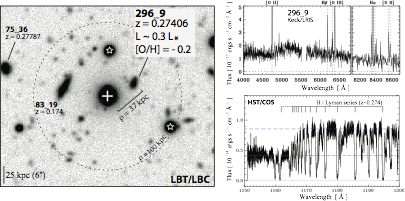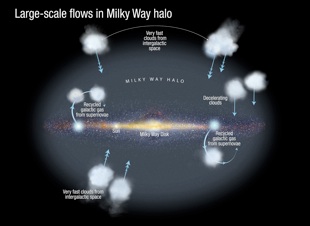Galaxy Formation & Evolution
Observational Cosmology
Galaxy Formation & Evolution
Observational Cosmology
My current research interests lie in galaxy halos and the evolution of galaxies.
With the extremely sensitive high resolution UV spectrograph (COS) onboard the Hubble Space Telescope coupled with ground-based observatories (LBT, Keck,...), I pursue some of the science frontier questions in modern astrophysics and cosmology: How do galaxies get their gas? What controls the recycling of gas in and out of galaxies?

According to cosmological simulations, many galaxies get their gas through cold flow accretion in intergalactic filaments connecting to galaxies (see right figure below). Little evidence has been reported to support this conclusion. Our group reported the discovery of a very low metallicity Lyman limit system (LLS - tracer of the circumgalactic medium - CGM - of galaxies, see left figure below). We show that this gas is associated with a solar-metallicity galaxy at an impact parameter 37 kpc. This is the best-yet observational evidence for a cold flow accretion as those present in numerical simulations of galaxies. Other groups have now reported similar findings, supporting our original conclusions.
I developed a new statistical methodology to determine the distances of the population of fast moving ionized gas clouds seen toward high galactic latitude sight lines. I have demonstrated that these clouds covering much of the Galactic sky reside in the halo within about a Galactic radius from the sun. This identifies the reservoir of gas to sustain star formation in the Milky Way for billions of years.
For more see Lehner et al. 2012, Lehner & Howk 2011, 2010
What’s keeping Milky Way’s lights on?
How do galaxies get their gas?
With my Hubble Cycle 17 observations, I have shown the HVCs reside in the low halo of the Milky Way and contain a significant mass. With my Hubble Cycle 20 program, I have designed an experiment where I will estimate the covering factor of the HVCs as a function of vertical height to test the predictions of hydrodynamical simulations and assess the ultimate fate of the HVCs. Stay tuned, Hubble observations are underway!

With my colleagues, I have now determined the metallicity of many LLS to statistically assess for the first time the metallicity distribution of the CGM. Surprisingly I’ve found that metallicity distribution of the CGM is bimodal with peaks at about 2% and 40% solar metallicity! Stay tuned, more to come very soon!!

